Topics
- Biofuel Policy & India’s ambition to make Global Biofuel Alliance
- DPT 3 Vaccination
- Global South origin and its importance
- WADA and NADA
- Strategic oil reserves
- Digitalization and curb on illegal land holdings – Murmu
- Rock Art
Topic 1: Biofuel Policy & India’s ambition to make Global Biofuel Alliance
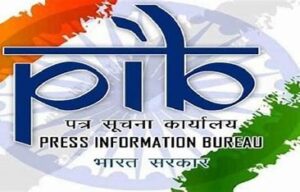
Syllabus: GS 3- Conservation, environmental pollution and degradation,
Syllabus: GS 3- Food processing and related industries in India
News
- The upcoming 14th Clean Energy Ministerial and Eighth Mission Innovation (CEM14/MI-8) conference, scheduled in Goa from July 19-22, 2023, will witness the establishment of the Global Biofuel Alliance (GBA).
- Led by India during its G20 Presidency, with support from Brazil and the United States, the GBA aims to foster international collaboration and cooperation to promote the acceptance and utilization of biofuels.
- This alliance seeks to leverage the transformative potential of biofuels in economic growth, rural development, energy self-sufficiency, reduced air pollution, and the global transition to clean energy.
Understanding Biofuel:
- Biofuel is a renewable energy source derived from biological sources, such as plants, agricultural crops, organic waste, or animal by-products.
- Its production and use aim to reduce greenhouse gas emissions and promote sustainability.
- There are key types of biofuels, including:

- Bioethanol: An alcohol-based fuel produced by fermenting sugar or starch crops like sugarcane, corn, or wheat. Bioethanol is commonly used as a blend in gasoline for transportation.
- Biodiesel: Produced from vegetable oils, animal fats, or recycled cooking oil, biodiesel can be used as a direct replacement for or blended with conventional diesel fuel in vehicles.
- Biogas: Primarily composed of methane, biogas is produced through the anaerobic digestion of organic waste materials like agricultural residues, food waste, or sewage. It can be used for electricity generation, heating, or as a vehicle fuel.
Generations of Biofuel
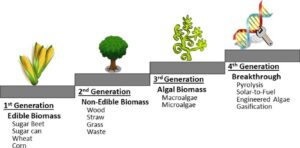
Objectives and Initiatives of the Global Biofuel Alliance (GBA)
- Developing Robust Markets and Facilitating Global Trade: The GBA aims to establish strong biofuel markets worldwide and facilitate global trade in biofuels.
- Policy Coordination and Technical Support: The alliance will promote policy coordination, share policy lessons, and provide technical support to national biofuel programs globally.
- Collaboration and Synergy: The GBA seeks to collaborate with existing regional and international agencies, maximizing impact and accelerating the growth of the biofuel industry.
Significance of GBA
- Reducing Dependence on Conventional Hydrocarbons:
- The establishment of the Global Biofuel Alliance showcases India’s commitment to reducing its reliance on conventional hydrocarbons.
- By promoting biofuels, the alliance seeks to address the need for increased production by OPEC+ countries.
- Transformative Opportunities:
- It can drive economic growth by promoting biofuel industries, create job opportunities, and contribute to rural development.
- Additionally, biofuels can enhance energy self-sufficiency, reducing the nation’s dependence on foreign oil.
- Moreover, widespread adoption of biofuels will lead to a significant reduction in air pollution and contribute to a cleaner and more sustainable energy transition.
- Accelerating Sustainable Biofuel Adoption:
- One of the primary objectives of the alliance is to expedite the adoption of sustainable biofuels.
- By fostering international collaboration and cooperation, the GBA can facilitate knowledge sharing, technological advancements, and policy support, making it easier for countries to embrace and integrate biofuels into their energy mix.
India’s Remarkable Progress in Biofuels
- Ethanol Production: In 2020-21, India produced 4.08 billion liters of ethanol, achieving a blending rate of 10.02%. This significantly reduced CO2 emissions and foreign exchange expenses.
- Blending Targets: India’s current target is to achieve a 12% blending rate by 2022-23, with the ultimate goal of 20% by 2025.
- Compressed Bio-Gas (CBG) Program: India promotes CBG as a clean fuel derived from waste through the Sustainable Alternative Towards Affordable Transportation (SATAT) program.
Around 16,164 tonnes of CBG have been sold through 46 established CBG plants. The goal is to install 5,000 CBG plants across India by 2024, contributing to waste management and pollution reduction.
- Sustainable Aviation Fuel (SAF): India conducted its first commercial passenger flight using domestically produced sustainable aviation fuel (SAF), showcasing its commitment to decarbonizing the aviation sector.
Inspiration from the International Solar Alliance (ISA)
- The Global Biofuel Alliance draws inspiration from the success of the International Solar Alliance (ISA), jointly initiated by India and France in 2015.
- The ISA has significantly contributed to combating climate change through the widespread adoption of solar energy solutions.
Conclusion
With India’s leadership in the G20 Presidency, the Global Biofuel Alliance is poised to revolutionize the global biofuel industry.
Its ambitious targets and initiatives will pave the way for a greener and more sustainable future, reducing carbon emissions, achieving energy independence, and fostering a clean energy transition.
Topic 2: India recorded all-time high of 93% DPT3 immunisation coverage in 2022: WHO

Syllabus: GS 2- Issues relating to Health
What in News?
- In 2022, India achieved a significant milestone in immunization efforts, with the coverage rate for DPT3 vaccines (diphtheria, pertussis, and tetanus) reaching an all-time high of 93%.
- This remarkable accomplishment surpassed the pre-pandemic record of 91% in 2019, indicating substantial progress in ensuring the protection of the population against these three infectious diseases.
Understanding DPT3 Vaccines
- DPT3 vaccines refer to a combination vaccine that offers protection against diphtheria, pertussis (whooping cough), and tetanus.
- Each of these diseases poses unique health risks:
- Diphtheria: A bacterial infection that primarily affects the respiratory system, causing severe throat and nose congestion, difficulty breathing, and, in severe cases, heart and nerve damage.
- Pertussis (Whooping Cough): A highly contagious respiratory infection caused by the bacterium Bordetella pertussis. It leads to severe coughing fits, often accompanied by a distinctive “whooping” sound when gasping for breath, and can be particularly dangerous for infants and young children.
- 3. Tetanus: Also known as lockjaw, it is a bacterial infection caused by the bacterium Clostridium tetani. Tetanus enters the body through wounds or cuts and produces a toxin that affects the nervous system, leading to muscle stiffness and spasms, particularly in the jaw and neck muscles.
WHO Records on Immunization Progress
The World Health Organization (WHO) reported encouraging statistics for the South-East Asia Region regarding vaccination coverage:
- DPT3 Coverage Recovery: The region witnessed a significant increase in DPT3 coverage, reaching pre-pandemic levels of 91% in 2022, up from 82% in 2021. This achievement reflects a concerted effort to protect populations against preventable diseases.
- Measles Vaccine Coverage: In addition to DPT3 vaccines, the region experienced a six percent improvement in measles vaccine coverage, with rates rising to 92% in 2022 from 86% in 2021. This progress represents an essential step towards eliminating measles and its devastating consequences.
- Decline in Zero-Dose and Partially Vaccinated Children: Encouragingly, the number of zero-dose children (those who had not received even the first dose of the DPT vaccine) halved from 4.6 million in 2021 to 2.3 million in 2022. Additionally, the number of partially vaccinated children (those who received at least one dose but not the complete three-dose series) decreased from 1.3 million in 2021 to 650,000 in 2022. These improvements indicate increased accessibility and awareness of immunization programs.
Various Children Immunisation programme
- Measles Vaccine: This vaccine guards against measles, a highly contagious viral disease.
- Oral Polio Vaccine (OPV): OPV is administered in three doses, typically at intervals of four weeks, to provide immunity against the polio virus.
- BCG Vaccine: The BCG vaccine safeguards children against tuberculosis, a bacterial disease, and also offers some protection against leprosy.
- DPT Vaccine: The DPT vaccine is a combination vaccine that provides protection against three infectious diseases in humans: diphtheria, pertussis (whooping cough), and tetanus.
Conclusion:
- The progress in vaccination coverage in the WHO South-East Asia Region, especially in India, is commendable.
- Achieving an all-time high of 93% coverage for DPT3 vaccines demonstrates the commitment of healthcare authorities and communities to protect against diphtheria, pertussis, and tetanus.
- As measles vaccine coverage also improves, the region moves closer to achieving disease control and safeguarding public health.
- Efforts to reduce the number of zero-dose and partially vaccinated children signify a step forward in ensuring comprehensive protection for the younger population.
- Continued focus on immunization programs and awareness campaigns will be crucial to sustain and build upon these achievements.
PRELIMS QUESTION
- Which of the following diseases are preventable by DPT vaccine?
1.Diphtheria
2.Tetanus
3.Tuberculosis
4.Measles
Select the correct answer using the code given below:
(a)1 and 2 only
(b)2 and 3 only
(c)1 and 3 only
(d)1,2,3 and 4
Additional Read: Mission Indradhanush
Topic 3. Global South origin and importance
![]()
Syllabus GS 2: Effect of policies and politics of developed and developing countries on India’s interests,
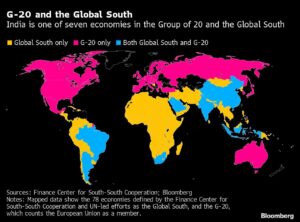
Introduction
- The term “Global South” refers to a group of countries in Africa, Asia, and Latin America often described as ‘developing,’ ‘less developed,’ or ‘underdeveloped.’
- These nations face higher levels of poverty, income inequality, and challenging living conditions compared to the “Global North.”
- The unwillingness of many leading countries in Africa, Asia, and Latin America to stand with NATO over the war in Ukraine has once again brought the term “Global South” to the forefront.
Historical Background:
- The term “Global South” emerged in 1969 when political activist Carl Oglesby argued that the Vietnam War represented a history of northern “dominance over the global south.”
- Previously, these countries were commonly referred to as the ‘Third World’ until the fall of the Soviet Union in 1991.
- Following the end of the Cold War and the rise of the non-aligned movement, the term gained momentum.
Features of the Global South:
- The Global South primarily consists of lower-income countries in Africa, Asia, and South America, with a history of imperialism and colonial rule.
- Many of these nations are in the process of industrialization and have been described as newly industrialized.
- Prominent countries within the Global South include Brazil, China, India, Indonesia, and Mexico, known for their large populations and economies.
Need for Classification:
- The term ‘Global South’ provides a broader and more inclusive classification based on shared histories of colonization and similar socioeconomic indicators.
- It addresses the critique of earlier terms, such as the East/West binary and the developed/developing categorization, which perpetuated stereotypes and favored Western ideals.
Global South amid Ukrainian War:
- The rise of countries like India and China challenges the dominant global order led by the US, leading to increased South-South cooperation.
- This shift questions the notion of the North as the ideal, giving more significance to the Global South.
- However, the classification has faced criticism for its broadness, concerns about resource accumulation, and neglect of Africa.
Significance of the Global South:
- Cooperation within the Global South can unlock significant potential for progress, including technical and ideas exchanges, sharing manufacturing best practices, and more.
- India aims to unite Global South countries in adopting an action-oriented approach, highlighting common concerns such as energy security, justice, and sustainable energy transitions.
Challenges for Consolidation:
- Debates over climate reparations have triggered controversies, with some arguing that China and India should contribute more due to their increasing industrialization and historical carbon emissions.
- The ongoing Russia-Ukraine war has also impacted least developed countries (LDCs) and prompted them to align more closely with China’s Belt and Road Initiative.
- Additionally, the dominance of the US in international affairs poses challenges for the consolidation of the Global South.
Way Forward:
- India must actively engage with regional politics within the developing world to champion the Global South.
- Developing a tailored policy approach that addresses the varying needs and capabilities of member countries is crucial.
- India’s development partnerships should prioritize consultation, outcome orientation, people-centric approaches, and respect for the sovereignty of partner countries.
- Distinguishing India’s approach from that of China can help promote sustainable development within the Global South, avoiding debt traps and financially unsound undertakings.
Conclusion:
Collaboration between the Global South and India holds the potential to lead to significant advancements in various fields.
By recognizing the significance of the Global South in shaping global politics, India can play a crucial role in fostering inclusive and sustainable development among these nations.
Topic 4: WADA and NADA

Syllabus GS 2: Important International institutions
Syllabus GS 2: Issue related to Health
Introduction
- WADA stands for World Anti-Doping Agency, an international organization that promotes and coordinates the fight against doping in sports.
- NADA stands for National Anti-Doping Agency, the national body responsible for implementing anti-doping rules and policies in India.
Both agencies are signatories to the World Anti-Doping Code, a set of rules and standards that harmonize anti-doping efforts across sports and countries.
Recent Developments
- On July 19, 2023, WADA published a report following an investigation into allegations that elements of NADA’s testing program were not in accordance with the WADA Code and the International Standard for Testing and Investigations (ISTI).
- The investigation, known as Operation Carousel, was launched in 2018 and uncovered evidence that NADA did not carry out adequate testing on some athletes in NADA’s registered testing pool (RTP) while also failing to put in place appropriate monitoring of athletes’ whereabouts information.
- The investigation monitored select sports and athletes within India and, as a result, in cooperation with NADA, 12 positive tests and 97 whereabouts failures of 70 athletes were identified. These are now subject to results management processes as appropriate.
- The investigation also revealed that NADA was lacking in resources, both human and financial, and did not have an effective intelligence or investigative capability.
- Since Operation Carousel began to engage openly with NADA in late 2022, NADA has strengthened its testing program by improving internal processes and bringing in significant additional resources. As a result, both the collection of blood samples and out-of-competition testing (urine and blood) has increased.
- Moreover, NADA has doubled its sample collection staff, including doping control officers, and made significant improvements to its whereabouts management.
India Specific Points
Doping Statistics
- According to the Athletics Integrity Unit (AIU) of World Athletics, India has recorded 62 doping violations by athletes since 2017, making it the second-highest in the world after Russia (87 violations).
- Out of the 62 Indian violators, 45 were men and 17 were women.
- According to the World Anti-Doping Agency (WADA) report for 2021, India ranked third in the world for doping cases with 224 violations across 41 sports, behind Russia (336) and Italy (240) .
- The most common substances detected were anabolic steroids, stimulants and diuretics.
Doping Challenges
- Lack of awareness and education among athletes and coaches about the prohibited substances and their health risks.
- Lack of adequate testing and monitoring of athletes’ whereabouts by NADA, especially during the COVID-19 pandemic.
- Lack of effective intelligence and investigation capabilities to detect and deter doping practices.
- Lack of sufficient resources, both human and financial, to implement a robust anti-doping program.
- Lack of transparency and accountability in the results management and sanctioning processes.
Doping Consequences
- Doping has serious consequences for Indian sports, such as:
- Loss of credibility and reputation in the international arena.
- Loss of medals and rankings in major competitions.
- Loss of eligibility and funding for future events.
- Loss of health and well-being for the athletes involved.
- Loss of trust and confidence among the fans and stakeholders.
Conclusion
WADA and NADA are two important agencies that work to ensure fair play and clean sport.
However, WADA’s investigation has exposed NADA’s failures and irregularities in its anti-doping program, which could jeopardize the credibility and reputation of Indian sports.
NADA has taken some corrective measures to address the issues raised by WADA, but it remains to be seen if they are sufficient and effective to prevent further violations and sanctions.
Topic 5: Strategic Oil Reserves of India
GS 3
Introduction
- Strategic oil reserves are substantial stockpiles of crude oil that are maintained by the government of a country to safeguard the economy and help maintain national security during an energy crisis.
- India, being the world’s third-largest oil importer and consumer, has built its strategic oil reserves at three locations in southern India: Visakhapatnam, Mangalore and Padur.
These reserves are meant to provide a buffer against external supply disruptions and volatility of oil prices.
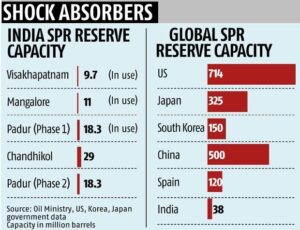
Phase I
- Under the first phase of the strategic oil reserve project, the Indian Strategic Petroleum Reserves Limited (ISPRL), a wholly owned subsidiary of the Oil Industry Development Board (OIDB), constructed underground rock caverns for storage of 5.33 million metric tons (MMT) of crude oil at three locations.
- The total storage capacity of these caverns is equivalent to 9.5 days of India’s crude oil requirement.
- The table below shows the details of the phase I locations and capacities.
| Location | Capacity (MMT) | Capacity (million barrels) |
| Visakhapatnam | 1.33 | 9.77 |
| Mangalore | 1.50 | 11 |
| Padur | 2.50 | 18.37 |
| Total | 5.33 | 39.14 |
India took advantage of the global low crude oil prices in April and May 2020 and filled these reserves completely, leading to a saving of INR 5000 crore for the government.
Phase II
- In the 2017-18 budget speech, the finance minister announced that two more caverns will be set up at Chandikhol in Odisha and Bikaner in Rajasthan as part of the second phase.
- In June 2018, the government approved the construction of a new storage facility at Chandikhol and doubling the capacity at Padur.
- This would raise India’s strategic reserve capacity to 11.83 MMT or 86.62 million barrels, equivalent to 22 days of crude oil requirement.
The table below shows the details of the phase II locations and capacities.
| Location | Capacity (MMT) | Capacity (million barrels) |
| Chandikhol | 4.00 | 29.32 |
| Padur (additional) | 2.50 | 18.37 |
| Total | 6.50 | 47.69 |
The government is exploring a public-private partnership (PPP) model for creating commercial-cum-strategic reserves in phase II, where a private firm or consortium will run the facilities and share the storage with the government for emergency needs.
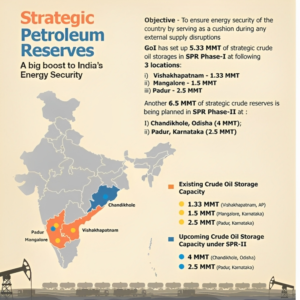
Benefits and Challenges
Benefits:
- Enhancing energy security by reducing dependence on imports and cushioning against supply shocks.
- Stabilizing domestic oil prices by moderating the impact of global price fluctuations.
- Leveraging geopolitical influence by participating in coordinated actions with other oil-consuming countries.
- Saving foreign exchange by buying oil when prices are low and selling when prices are high.
Challenges:
- High capital and operational costs involved in constructing and filling the caverns.
- Technical and environmental risks associated with storing large quantities of flammable and hazardous substances underground.
- Optimal utilization and management of the reserves, including deciding when to release or replenish them.
- Coordination and cooperation with other stakeholders, such as oil-producing countries, international agencies, private players and consumers.
Conclusion
Strategic oil reserves are an important component of India’s energy security strategy, as they provide a buffer against external shocks and volatility in the oil market.
India has made significant progress in building its strategic oil reserves under phase I and is planning to expand them further under phase II.
However, there are also some challenges that need to be addressed to ensure optimal utilization and management of the reserves.
Topic 6: Digitisation will curb land-linked illegal activities: President Droupadi Murmu

Syllabus GS 2 + GS 3
News
- President Droupadi Murmu, while addressing the ‘Bhoomi Samman 2023’ function organized by the Union Ministry of Rural Development, highlighted the significance of the Unique Land Parcel Identification Number in the Digital India Land Information Management System.
- She drew parallels with the Aadhaar Card, stating that this unique identification system would help bring transparency to land-related activities and curb unethical and illegal practices.
Benefits of Digitization:
- President Murmu emphasized that digitization of land records and their linkage with various government departments would enable the proper implementation of welfare schemes.
- Additionally, in the event of natural calamities such as floods and fires, digitization would prove beneficial in preventing the loss of important land-related documents.
Impact on Development:
- The President emphasized that the modernization and digitization of land records would greatly impact the country’s development.
- By enabling proper usage of land parcels and facilitating the formulation and implementation of new schemes, digitization would contribute to the overall progress of the nation.
Recognition at ‘Bhoomi Samman 2023’:
During the event, President Murmu presented the “Bhoomi Samman 2023” award to state secretaries and district collectors along with their teams who demonstrated exceptional achievements in attaining saturation of the core components of the Digital India Land Records Modernization Programme. Their efforts were recognized for their role in advancing the digitization of land records and promoting transparency in land-related activities.
Topic 7: Rock Art

Syllabus GS 1: Indian culture will cover the salient aspects of Art Forms, literature and Architecture from ancient to modern times.
Introduction
Rock art is a term for human-made markings, paintings, carvings or sculptures on natural stone surfaces, usually from the ancient or prehistoric era.
Rock art can be found in many regions of the world and has different styles, techniques and meanings. Rock art can provide insights into the culture, beliefs and daily life of the people who created it.
Types of Rock Art
There are four main types of rock art:


- Pictographs: Drawings or paintings on rock surfaces, using pigments made from clay, minerals, charcoal or other materials. Pictographs can be applied with fingers, brushes or pipes.
- Petroglyphs: Carvings or inscriptions on rock surfaces, using tools such as flint or metal. Petroglyphs can be engraved, scratched, pecked or chipped.
- Rock reliefs: Sculptures on rock surfaces, usually by removing the surrounding material to create a raised image. Rock reliefs can be found on cliffs, boulders or platforms.
- Geoglyphs: Patterns or shapes on the ground, made by arranging rocks, stones or other materials. Geoglyphs can be seen from a distance or from the air.
Examples of Rock Art
- Cave paintings:
- Paintings on the walls or ceilings of caves or rock shelters, often depicting animals, humans, hunting scenes or abstract symbols.
- Cave paintings are found in many parts of the world, such as Europe, Africa, Australia and Asia.
- Some of the oldest known cave paintings date back to the Upper Paleolithic period (about 40,000 to 10,000 years ago), such as those in Altamira (Spain), Lascaux (France) and Chauvet (France).
- Petroglyphs:
- Carvings on rock surfaces, often depicting animals, humans, geometric shapes or symbols.
- Petroglyphs are found in many parts of the world, such as North America, South America, Africa, Asia and Australia.
- Some of the oldest known petroglyphs date back to the Neolithic period (about 10,000 to 3,000 years ago), such as those in Bhimbetka (India), Valcamonica (Italy) and Côa Valley (Portugal).
- Rock reliefs:
- Sculptures on rock surfaces, often depicting religious figures, rulers, events or scenes.
- Rock reliefs are found in many parts of the world, such as Asia, Africa and Europe.
- Some of the oldest known rock reliefs date back to the Bronze Age (about 3,000 to 1,200 years ago), such as those in Persepolis (Iran), Behistun (Iran) and Mount Nemrut (Turkey).
- Geoglyphs:
- Patterns or shapes on the ground, often depicting animals, humans or symbols.
- Geoglyphs are found in many parts of the world, such as South America, North America and Europe.
- Some of the oldest known geoglyphs date back to the Iron Age (about 1,200 to 500 years ago), such as those in Nazca (Peru), Blythe Intaglios (USA) and Uffington White Horse (UK).
Major Sites of Indian Rock Art
India has a rich and diverse heritage of rock art, dating from the Paleolithic to the medieval periods. Rock art sites are found in almost every state of India, but some of the most prominent and well-known ones are:
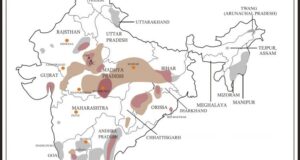
- Bhimbetka rock shelters: A World Heritage Site in Madhya Pradesh, with rock art ranging from the Mesolithic to the historical times. The paintings depict animals, humans, hunting scenes, rituals, dances and geometric designs. Some of the oldest paintings are about 30,000 years old.
- Hiregudda: A site near Badami in Karnataka, with rock paintings and engravings from the Neolithic to the Iron Age. The paintings depict animals, humans, weapons, chariots and symbols. Some of the engravings are similar to those found in Indus Valley Civilization sites.
- Mangar Bani: A site in Haryana, with cave paintings and tools discovered in 2021. The paintings depict animals, humans and geometric patterns. The site is believed to be one of the largest and oldest Paleolithic sites in the Indian subcontinent, dating back to about 100,000 years ago
- Ajanta caves: A World Heritage Site in Maharashtra, with rock-cut Buddhist caves and frescoes from the 2nd century BCE to the 6th century CE. The paintings depict scenes from the life of Buddha, Jataka tales, deities and courtly life. The paintings are known for their naturalism, realism and use of perspective.
- Ellora caves: A World Heritage Site in Maharashtra, with rock-cut Hindu, Buddhist and Jain caves and sculptures from the 6th to the 10th century CE. The paintings depict scenes from Hindu epics, Buddhist legends and Jain cosmology. The paintings are known for their diversity, intricacy and symbolism.
Significance of Rock Art
- It is a form of cultural expression and creativity that reflects the worldview and identity of the people who made it.
- It is a source of historical and archaeological information that can reveal aspects of the past that are not recorded in written documents.
- It is a manifestation of human interaction with nature and landscape that shows how people perceived and used their environment.
- It is a symbol of spiritual and religious beliefs and practices that can indicate how people related to supernatural forces and entities.
It is a part of cultural heritage and identity that can inspire pride and respect among present-day communities.


